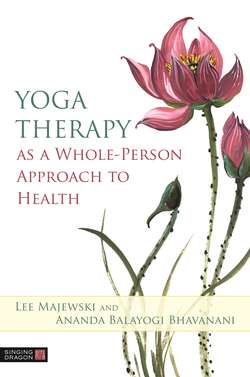Читать книгу Yoga Therapy as a Whole-Person Approach to Health - Lee Majewski - Страница 20
На сайте Литреса книга снята с продажи.
Yoga as the original mind–body medicine
ОглавлениеYoga is one of the six reverential perspectives of the universe (Shat Darshana) as codified by the great seers (Rishis) of the pan-Indian cultural tradition. It provides us with a practical framework and perspective of the manifest universe (prakruti) and the pure consciousness that lies behind it (purusha). The moral and ethical foundations of yoga (yama, niyama) provide inner strength, conviction, and self-responsibility that manifest in both our personal and social life. They guide our attitudes with regard to what is right and wrong in our life and in relation to our Self, our family, and the entire social system. These changes in our attitude and behavior will go a long way in helping to prevent the root causes of stress in our life.
The five moral restraints of subhuman tendencies (pancha yama) include non-violence (ahimsa), truthfulness (satya), non-stealing (asteya), channeling of creative impulses in tune with the higher consciousness (brahmacharya), and non-covetousness (aparigraha). The ethical observances of a humane nature (pancha niyama) are purity (saucha), contentment (santhosha), leading a disciplined and minimalistic life (tapas), introspective self-analysis (swadhyaya), and attitude of acceptance of the Almighty (Iswarpranidhana).
Patanjali advocates adopting appropriate attitudes towards different situations, people, and events in our life. These include friendliness towards those who are at ease with themselves (maitri), compassion towards those who are suffering (karuna), cheerfulness towards the noble (mudita), and equanimity towards the non-virtuous (upekshanam). This enables us to have a clearer perspective on life and to deal with our problems more effectively. He further advises us to cultivate a contrary view (Pratipaksha Bhavanam) when faced with negative thoughts of a destructive nature that otherwise ultimately only lead to suffering.
The triple humor (tridosha—vata, pitta, and kapha)1 theory of health and disease that developed during the late Vedic period is common to virtually all traditional Indian systems of medicine. Health is understood to be the balanced harmony of the three humors in accordance with individual predisposition, while disease results from an imbalanced disharmony. The Tirumandiram of Tirumoolar, the 3000-versed Tamil treatise by the Dravidian saint, prescribes the practice of yoga at different times of the day to relieve disorders arising from these imbalances. According to him, the practice of yoga at dusk relieves mucous, phlegmatic (kapha) disorders, practice at noon relieves gaseous, movement-based (vata) disorders, and practice in the morning relieves acidic, bilious (pitta) disorders.
According to the Bhagavad Gita,2 yoga is defined as the disassociation from our tendency to attach to our suffering, pain, and illness (dukkhasamyogaviyogam yoga samjnitham; Bhagavad Gita VI:23). People with health conditions often tend to identify themselves with that condition and as a patient of that condition. This results in statements such as, “I am a diabetic” or “I am a hypertensive.” In some cases this actually becomes a very strong identification and they claim ownership of that condition with statements such as, “My diabetes,” “My hypertension,” or “My cancer.” Unless this mal-identification with their diseased state is broken, it becomes very difficult to actually bring about a “cure” for the individual.
One of the foremost concepts of yoga therapy is that the mind (adhi) influences the body, thus creating disease (vyadhi). This is the basis of psychosomatics and mind–body medicine, and is termed adhi vyadhi or adhija vyadhi, where the mind causes the disease in the physical body. In modern language, this is also termed psychoneuroimmunology, as modern health systems have started to realize that how we think and feel can positively or negatively influence our nervous, endocrine, and immune responses. One path leads to health while the other leads to disease and suffering.
Virtually every health problem that we face today either has its origin in psychosomatics or is worsened by the psychosomatic aspect of the disease. The mind and the body seem to be continuously fighting each other. What the mind wants, the body won’t do, and what the body wants, the mind won’t do. This creates a dichotomy, a disharmony, in other words, a disease. Yoga helps restore balance and equilibrium by virtue of the internal process of unifying the mind, body, and emotions. The psychosomatic stress disorders that are so prevalent in today’s world can be prevented, controlled, and possibly even cured via the sincere and dedicated application of yoga as a therapy.
The yogic concept of health and disease enables us to understand that the cause of physical disorders stems from the seed in the mind and beyond. The disturbed mind (adhi) is the primary root cause while the physical disease (vyadhi) is only the final manifest effect in yogic philosophy. By paying careful attention to personal history, the origins of psychosomatic disease can nearly always be traced back to patterns of mental and emotional distress.
According to yogic thought, all diseases start not with the body, but from blockages in our subtler energy systems. All disturbances start at the psychic level beyond the mind (the psyche in Indian thought goes all the way up to the sense of Self), come down through a disturbed mind, and then manifest in the subtle energy channels (prananadi), and finally settle in the physical body. Therefore, the five-layered model of existence (pancha kosha or pancha maya) is one of the ancient Indian models that helps us to look for a root cause of the manifest problem or disease.
